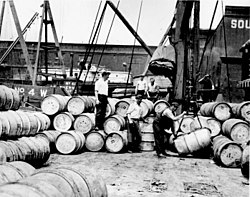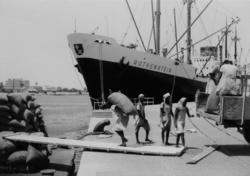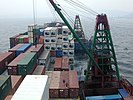Stevedore *** http://frankbalthis.photoshelter.com/image/I0000q9MhRzUnmvw
From Wikipedia, the free encyclopedia
"Docker" redirects here. For other uses, see Docker (disambiguation).
A stevedore, dockworker, docker, dock laborer, wharfie, wharf rat, lumper, and/or longshoreman is a waterfront manual laborer who is involved in loading and unloading ships.
Contents
[hide]Etymology[edit]
The word stevedore originated in Portugal or Spain, and entered the English language through its use by sailors. It started as aphonetic spelling of estivador (Portuguese) or estibador (Catalan and Spanish), meaning a man who loads ships and stows cargo, which was the original meaning of stevedore (though there is a secondary meaning of "a man who stuffs" in Spanish); compare Latinstīpāre meaning to stuff, as in to fill with stuffing.[1] In the United Kingdom, men who load and unload ships are usually called dockers, in Australia wharfies, while in the United States and Canada the term longshoreman, derived from man-along-the-shore, is used.[2]Before extensive use of container ships and shore-based handling machinery in the United States, longshoremen referred exclusively to the dockworkers, while stevedores, in a separate trade union, worked on the ships, operating ship's cranes and moving cargo. In Canada, the term stevedore has also been used, for example, in the name of the Western Stevedoring Company, Ltd., based inVancouver, B.C., in the 1950s.[3]
Loading and unloading ships[edit]
| Admiralty law |
|---|
| History |
| Features |
| Contracts of affreightment |
| Types of charter-party |
| Parties |
| Judiciary |
| International conventions |
| International organisations |
Loading and unloading ships requires knowledge of the operation of loading equipment, the proper techniques for lifting and stowingcargo, and correct handling of hazardous materials. In addition, workers must be physically strong and be able to follow orders attentively.
In earlier days before the introduction of containerization, men who loaded and unloaded ships had to tie down cargoes with rope. A type of stopper knot is called the stevedore knot. The methods of securely tying up parcels of goods is called stevedore lashing orstevedore knotting. While loading a general cargo vessel, they use dunnage, which are pieces of wood (or nowadays sometimes strong inflatable dunnage bags) set down to keep the cargo out of any water that might be lying in the hold or are placed as shimsbetween cargo crates for load securing.
Today, the vast majority of non-bulk cargo is transported in intermodal containers.[4] The containers arrive at a port by truck, rail or another ship and are stacked in the port's storage area. When the ship that will be transporting them arrives, the containers that it is offloading are unloaded by a crane. The containers either leave the port by truck or rail or are put in the storage area until they are put on another ship. Once the ship is offloaded, the containers it is leaving with are brought to the dock by truck. A crane lifts the containers from the trucks into the ship. As the containers pile up in the ship, the workers connect them to the ship and to each other. The jobs involved include the crane operators, the workers who connect the containers to the ship and each other, the truck drivers that transport the containers from the dock and storage area, the workers who track the containers in the storage area as they are loaded and unloaded, as well as various supervisors. Those workers at the port who handle and move the containers are likely to be considered stevedores or longshoremen.
Before containerization, freight was often handled with a longshoreman’s hook, a tool which became emblematic of the profession (mostly on the west coast of the United States and Canada).[5]
Traditionally, stevedores had no fixed job, but would arrive at the docks in the morning seeking employment for the day. Londondockers called this practice "standing on the stones",[6] while in the United States it was referred to as Shaping.[7] In Britain, due to changes in employment laws, such jobs have either become permanent or have been converted to temporary jobs.[citation needed]
Dock workers have been a prominent part of the modern labor movement.[8]
- Container handling in Hong Kong - 2005
By country[edit]
Australia[edit]
In Australia, the informal term "wharfie" (from wharf labourer) and the formal "waterside worker", include the variety of occupations covered in other countries by words like stevedore. The term "stevedore" is also sometimes used, as in the company name Patrick Stevedores. The term "docker" is also sometimes used, however in Australia this usually refers to a harbor pilot.
The Maritime Union of Australia has coverage of these workers, and fought a substantial industrial battle in the 1998 Australian waterfront dispute to prevent the contracting outof work to non-union workers.
In 1943 stevedores in Melbourne and Sydney were deliberately exposed to mustard gas while unloading the ship Idomeneus. The result was death and permanent disability—all as a result of military secrecy.[9]
New Zealand[edit]
New Zealand usage is very similar to the Australian version; "waterside workers" are also known as "wharfies." The 1951 New Zealand waterfront dispute, involving New Zealand stevedores, was the largest and most bitter industrial dispute in the country's history.
United Kingdom[edit]
In the United Kingdom, the definition of a stevedore varies from port to port. In some ports, only the highly skilled master of a loading gang is referred to as a "stevedore". "Docker" is the usual general term used in the UK for a man who loads or unloads ships and performs various other jobs required at a sea port.
It was once known to refer the those working on a ship—loading or unloading the cargo—as stevedores, while those working on the quayside were called dockers. Thus, the stevedores still did the "stuffing" and "unstuffing", with the dockers staying on the dock.
United States[edit]
In present-day American waterfront usage, a stevedore is usually a man or a company who manages the operation of loading or unloading a ship. In the 1800s, the word was usually applied to black laborers who loaded and unloaded bales of cotton and other freight on and off riverboats. In Two Years Before the Mast (1840), the author Richard Henry Dana, Jr. describes the steeving of a merchant sailing ship in 1834. This was the process of taking a mostly-full hold and cramming in more material. In this case, the hold was filled with hides from the California hide trade up to four feet below the deckhead (equivalent of 'ceiling'). "Books" composed of 25–50 cattle skins folded into a bundle were prepared, and a small opening created in the middle of one of the existing stacks. Then the book was shoved in by use of a pair of thick strong pieces of wood called steeves. The steeves had one end shaped as a wedge which was placed into the middle of a book to shove it into the stack. The other ends were pushed on by means of block and tackle attached to the hull and overhead beams and hauled on by sailors.
Typically one ethnic group dominated the stevedore market in a port, usually the Irish Catholics, as seen in the 1954 film about New YorkOn the Waterfront.[10] In New Orleans there was competition between the Irish and the blacks.[11]
In the Port of Baltimore, Polish Americans dominated. In the 1930s, about 80% of the Baltimore's longshoremen were Polish or of Polish descent.[12] The port of Baltimore had an international reputation of fast cargo handling credited to the well-organized gang system that was nearly free of corruption, wildcat strikes, and repeated work stoppages of its other East coast counterparts. In fact, the New York Anti-Crime Commission and the Waterfront Commission looked upon the Baltimore system as the ideal one for all ports. The hiring of longshoremen in Baltimore by the gang system dates back to 1913, when the ILA was first formed. The Polish longshoremen began setting up the system by selecting the most skilled men to lead them. This newly formed gang would usually work for the same company, which would give the priority to the gang. During the times where there was no work within the particular company, the gang would work elsewhere, or even divide to aid other groups in their work, which would speed up the work and would make it more efficient[13] In an environment as dangerous as a busy waterfront, Baltimore's gangs always operated together as a unit, because the experience let them know what each member would do at any given time making a water front a much safer place.[14] At the beginning of the Second World War Polish predominance in the Port of Baltimore would significantly diminish as many Poles were drafted.
It is common but inaccurate to use the terms "stevedore" and "longshoreman" interchangeably.[13] However, even the U.S. Congress has done so in the Ship Mortgage Act, 46 app. U.S.C. section 31301(5)(C) which designates both "crew wages" and "stevedore wages" as preferred maritime liens. The intent of the statute was to give the wages of the seamen and longshoremen the same level of protection. Nevertheless, sometimes the word "stevedore" is still used to mean "man who loads and unloads a ship" as the British "docker".
Today, a stevedore typically owns equipment used in the loading or discharge operation and hires longshoremen who load and unload cargo under the direction of a stevedore superintendent. This type of work along the East Coast waterfront was characteristic of ports like New York, Boston, and Philadelphia.
Today, a commercial stevedoring company also may contract with a terminal owner to manage all terminal operations. Many large container ship operators have established in-house stevedoring operations to handle cargo at their own terminals and to provide stevedoring services to other container carriers.
One union within the AFL-CIO represent longshoremen: the International Longshoremen's Association, which represents longshoremen on the East Coast, on the Great Lakesand connected waterways and along the Gulf of Mexico. The International Longshore and Warehouse Union, which represents longshoremen along the West Coast, Hawaii and Alaska, was formerly affiliated with the AFL-CIO but disaffiliated in 2013.
Former stevedores and longshoremen include:
- Frithjof Bergmann – philosopher
- Mestre Bimba – founder of the Regional style of Capoeira
- Ronald Bird – English cricketer
- Jerry Colonna – Movie actor/comedian*
- Terry Bollea – Better known as professional wrestler Hulk Hogan
- Murray Bookchin – American libertarian socialist, founder of social ecology
- Harry Bridges – founder of the International Longshore and Warehouse Union (ILWU)
- James Braddock – heavyweight boxing champion from 1935 to 1937
- Joey Coyle – basis for the movie Money for Nothing
- Jack Dash – British Dock Workers Trade Union Leader
- Francois Faber – Road Cyclist
- Chief Dan George – Native American actor
- Danny Greene -American mobster
- Eric Hoffer – author and philosopher
- James J. Hill - Railroad industrialist and financier
- Brian Jacques – author of the Redwall book series
- Vladimir Kokkinaki – the most famous test pilot in the Soviet Union
- Mauno Koivisto – President of Finland from 1982 to 1994
- Artie Lange – comedian/radio personality, The Howard Stern Show
- Tom Mann – British trade unionist and organizer of the London Dock Strike of 1889
- Charles Manson – convicted murderer, worked as a longshoreman from 1954–1956
- Frank McCourt – noted Irish-American author
- Peter MacKay – Minister of National Defense of Canada [15]
- Daniel Patrick Moynihan – sociologist, Ambassador to the United Nations and to India, U.S. Senator from New York
- Michael "Ozzie" Myers – U.S. Representative from Pennsylvania
- Bruce Nelson – labor historian, author of Workers on the Waterfront
- Charles Plymell – poet
- Joe Rollino – boxer and strongman
- Glenn Theodore Seaborg – 1951 Nobel Prize Winner, member of The Manhattan Project [16]
- Hubert Selby, Jr. – Writer, Last Exit To Brooklyn
- Mark E. Smith – singer/songwriter of the British band The Fall
- Stan Weir – blue-collar intellectual and sociologist, founder of Singlejack Press
- Isaac Woodard – African-American victim of a notorious racist attack
- J. S. Woodsworth – a founder of the Cooperative Commonwealth Federation, the forerunner of the New Democratic Party of Canada
- Howard Zinn – historian, playwright and activist
In popular culture[edit]
- In the television series 24, Jack Bauer is in hiding as Frank Flynn, a longshoreman, at the beginning of Season 5. In the 24: Underground comic books, his cover identity of Borys is also a longshoreman.
- In episode 16, season 4 of Buffy The Vampire Slayer, Buffy notes that while reading her mother's mind in the past, she learned that Giles "makes love like a stevedore". She then asks Giles "What's a stevedore?"
- In 1949, reporter Malcolm Johnson was awarded a Pulitzer Prize for a 24-part investigative series titled Crime on the Waterfront published in the New York Sun. This material was fictionalized and used as a basis for the influential film, On the Waterfront, starring Marlon Brando as a longshoreman, and the working conditions on the docks figure significantly in the film's plot. Playwright Arthur Miller was involved in the early stages of the development of the film, and his play A View from the Bridge also deals with the troubled life of a longshoreman.
- In the HBO Series The Wire, the Stevedore Union and its members, particularly Frank Sobotka, working in Baltimore figure prominently in the second season's story.
- In the song by Jimmy Nail, Big River, there is the line "Now all the capstans and the cargo boats and stevedores are gone."
- Kill the Irishman features Ray Stevenson as Danny Greene head of the Longshoreman's Union.
- Poet Ella Wheeler Wilcox recited her poem, The Stevedores ("Here's to the Army stevedores, lusty and virile and strong ... ") while visiting a camp of 9,000 stevedores in France during World War I.[17]
- In the movie A League Of Their Own, Doris Murphy, played by Rosie O'Donnell, plays for the Staten Island Stevedores prior to joining the Rockford Peaches.[18]
- In the television series Nash Bridges, Nash's father, Nick Bridges, is a retired Longshoreman.









No comments:
Post a Comment